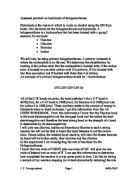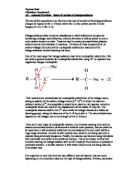I predict that iodine will have the quickest rate of reaction because out of the three elements there are it is the weakest bond. This is due to the decrease in bond enthalpy as the halogen atom radius increases the bond gets longer and weaker and chlorine is the most electronegative and iodine the least electronegative. Electronegativity is the ability of an atom to inductively pull electrons towards it. The more electronegative an atom, the tighter it pulls the electrons, the higher the electronegativity, the more strongly an atom attracts, and Note electronegativity is the characteristic of an atom to take up electrons from another atom in an attempt to fill its outer shell. The Bond Enthalpy is the energy required to break a chemical bond, Average bond enthalpies/kJmol-1: C-Cl 338, C-Br 276, C-I 238, Therefore iodine has the lowest bond enthalpy so easier its break, with chlorine being the hardest and iodine being the weakest. Iodine will also make a precipitate first.
Apparatus
• Safety spectacles
• Bunsen burner, tripod, gauze and bench protection sheet (or a thermostatically controlled water-bath, set at 60 C)
• Beaker, 250 cm
• Thermometer, 0—100°C
• 5 test-tubes fitted with corks
• Test-tube rack-
• Waterproof marker or china graph pencil -
• Protective plastic gloves
• measuring cylinder, 10 cm
• Ethanol, C2H5OH
• 1-chlorobutane C4H9
• 1-bromobutane, C4H9Br
• 1-iodobutane, C4H9I
• Silver nitrate solution 0.05 M AgNO3
• Stopclock (or clock with second’s hand)
Method
- Set up the apparatus, make sure none of the test tubes contain tap-water, as this would give an immediate precipitate with silver nitrate and spoil the results.
- Pour 2cm³of ethanol into each of the four test tubes and mark them with the letters A to C.
- Add 3-4 drops of 1-chlorobutane to A, 3-4 drops of 1- bromobutane to B, 3-4 drops of iodobutane to C.
- Pour about 5cm³ of silver nitrate solution into a fourth test-tube, to use as a comparison to see if precipitate has formed.
- Stand all the test tubes in the beaker and heat to 60 degrees. Once you’ve got 60 degrees remove Bunsen burner.
- Quickly add 1cm³ of aqueous silver nitrate to each of the tubes A to C and start the stop clock. Shake each of tube once to mix the contents, and leave in the water with the cork resting loosely on the tube to reduce evaporation.
- Watch the tubes continuously for about ten minutes and note, the time when a precipitate first appears in each tube as a definite cloudiness.
- Continue for about 30 minutes more, noting any further changes in the appearance of the precipitates.
Fair test
For a fair test I will keep the following the same:
- Carbon chain length.
- Volumes of solution
- Concentration of solution
One thing which I will change and is was having different halogens in the each of the halogenalknaes.
Safety
The equipment needed to ensure safety will be: goggles, gloves and long hair tied back. Halogenalkanes are highly flammable and other chemicals in the experiment can be corrosive. I didn’t use fluorine as a comparison of rate of reaction because it has the strongest bond enthalpy, so it would have been hard to break its bond, therefore would have taken to long for the experiment. Fluorine is also highly reactive.







